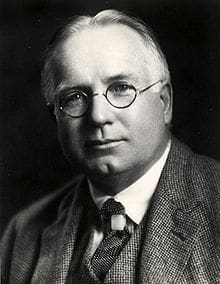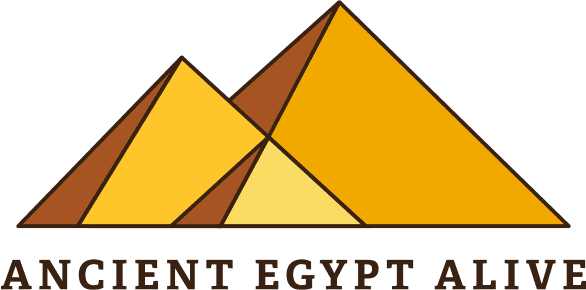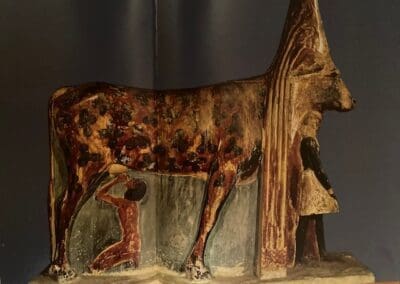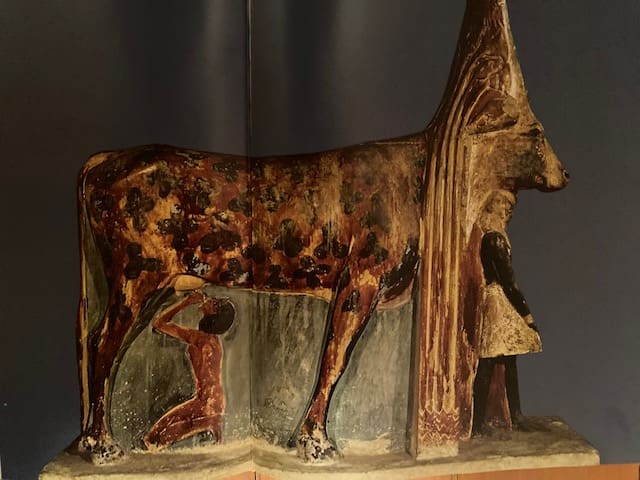- Photo by Laura Ranieri
In it, a sandstone statue of the goddess in cow form is suckling the new Kingdom Pharaoh Amenhotep II. Around this touching scene, there is a beautifully preserved sandstone shrine with all its original paint and a vaulted ceiling with blue and yellow stars. Scenes of Amenhotep II’s father, Thutmosis III (1479-1425) and his wife are shown worshipping Hathor in various vignettes along the wall.
The story of the discovery of this unsung masterpiece — by Toronto’s Royal Ontario Museum founder, Charles Currelly — is an exciting one. Few know it, so I will tell all.
Charles Currelly’s uncanny timing – in London at the right time.
In the years before he founded the first big museum in Toronto, intrepid young Canadian archaeologist and collector Charles Currelly from Exeter, Ontario was in Egypt engaged in important excavations. He had arrived in England on a cattle boat in 1902, and through a series of fortuitous events – including a shabti purchase at the British Museum – he came under the wing and mentorship of the great Flinders Petrie (the British father of Egyptology). Through Petrie, Currelly traveled to Egypt, learned archaeology, and worked alongside this great man at Abydos, Sinai, and even sites in the Delta. This was a far cry from his original mission in coming overseas as a young man: the pursuit of a socialist-themed Ph.D.

Charles Currelly c. 1902 at Abydos, Photo: ROM.on.ca
A jumbled mountain of temple debris –the Deir el Bahri excavations 1905-1907
Right beside (north of) the terraced mortuary temple of Hatshepsut lies a lump of rubble. It was once the great temple-tomb of King Mentuhotep II, destroyed by an ancient earthquake. From 1905 to 1907, this is where Currelly excavated at Deir el Bahri. as part of the Edouard Naville/Hall EEF archaeology team. Within the rubble of Mentuhotep II’s temple too, ruins of the New Kingdom temples of Thutmosis III and Amenhotep II have also been jumbled, likewise destroyed by the earthquake. Together these fallen temples comprised a big pile of temple debris which Currelly and the team laboured to tunnel through and excavate. Even today, a Polish team is still working hard to restore the site. In the jumble, many important artifacts and precious treasures from the early New and the early Middle Kingdom have since been found.
This includes the Hathor cow shrine.

Deir el Bahri showing Hatshepsut Temple and ruined temples of Mentuhotep II, (and Thutmosis III & Amenhotep II) (photo ancientegyptonline.co.uk)
The Canadian who slept with Hathor
Here is how Charles Currelly recounts the wonderful discovery of the Hathor cow shrine at this site — from his autobiography “I Brought the Ages Home.” Published 1956
“One day I was sitting on a stone when there was a big fall that threw a mass of dust into the air so that I could not see more than a foot or two in front of me. Before it had cleared a boy came to me, touched me, and said: “Master there is a statue.”
I hurried over to the spot and found myself looking into a hole where I could see the top of an arch, and inside a large stone statue of a cow with a golden head. The falling rubble had revealed a shrine…. I immediately sent for soldiers as I knew that news of this discovery would spread far and wide, especially as the cow’s head was covered with gold leaf and would be reported as a gold head. … a few military police arrived from Luxor, and I stationed them around the shrine.
In the middle of the night, I heard a drop or two of rain on the roof of my hut, and I got up and began to make my rounds as I usually did once every night. My own guards were at their place with their guns, sound asleep as usual…. But when I got up to the shrine, I found no one there, and therefore had to stay all night myself. In the morning, the soldiers appeared from the neighbouring temple with the excuse that they would have got into trouble if they got their uniforms wet! I dismissed them, and after that slept beside the statue until it was removed.” Charles Currelly.

- Hathor cow shrine c) wikipedia
- c. Laura Ranieri
- c) Sandro Vannini
- Laura Ranieri (from Egyptian Museum guide book)
The goddess who suckled kings: about Hathor statue itself.
Although showing scenes and cartouches of the great Thutmosis III (the Napoleon of Egypt) the shrine was likely commissioned by Amenohotep II, his son. It is this latter king who is being suckled by the goddess Hathor.
Hathor was a great goddess of music, love, beauty, and drunkenness. The ancient Egyptians believed Hathor lived in the mountains of Deir el Bahri – and took on the form of a cow; an animal deemed very beautiful to ancient Egyptians. In mythology, she suckled the baby Horus, god of the living king, in the reeds. Symbolically then, by showing himself being suckled by Hathor as a cow, Amenhotep II is also representing himself as a Horus (the living king) being suckled by the great goddess.
Here is how Charles Currelly lyrically describes the work:
“The goddess was made out of a fine-grained sandstone and painted… between her horns the great disc and plumes on each side. She was represented as coming out of the water with the lotus flowers caught in her horns, the long stems hanging down to the ground. Standing right in front of her, right under her nose, was a little prince carved in the round. … and on the right side was the same little prince with his mouth to one of the cow’s teets.”
This was a representation of the royal claim that not only was the royal family under the protection of the goddess, but in infancy the kings were actually suckled by her.” Charles Currelly (I Brought the Ages Home, 1956)
As Currelly documents, the great sculpture and the big painted stones that formed the shrine were transported to the Nile and sailed downstream to Cairo. The whole structure was recreated within the Egyptian Museum at Tahrir, where it stands today. And we hope, forever more. It is a jewel of the collection.
To read more about the museums in and around Cairo <read our museum mania blog>
To travel to Egypt with us on a small group learning tour <read about our tours>
And to read about some of the great items in Charles Currelly’s Egyptian gallery at the Royal Ontario museum <read our ROM blog>

Picture of Charles Currelly, Rom Founder, Wikipedia
The Story of ROM, Founder Charles Currelly: Egyptian Archaeology as the foundation of the Royal Ontario
A Live Talk at the Archaeology Institute of America, Toronto chapter, Tuesday, September 27 at 6pm
Speaker: Laura Ranieri Roy
Tuesday September 27, 2022 at 6pm
Anthropology Building, University of Toronto
AP130, 19 Russell Street, Toronto





